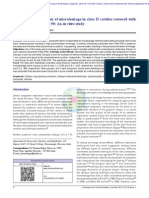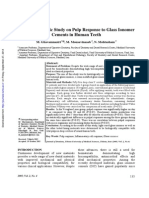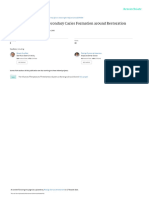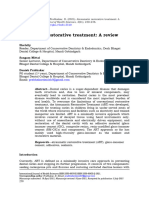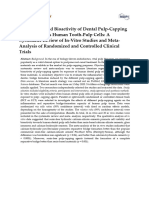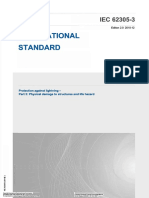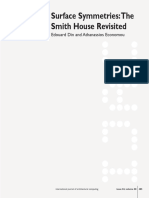Microleakage Assessment of Hydrophilic Pit and Fissure Sealants Fortified With Green Synthesized Silver Nanoparticles-An in Vitro Study
Microleakage Assessment of Hydrophilic Pit and Fissure Sealants Fortified With Green Synthesized Silver Nanoparticles-An in Vitro Study
Uploaded by
dr.m3.abazaCopyright:
Available Formats
Microleakage Assessment of Hydrophilic Pit and Fissure Sealants Fortified With Green Synthesized Silver Nanoparticles-An in Vitro Study
Microleakage Assessment of Hydrophilic Pit and Fissure Sealants Fortified With Green Synthesized Silver Nanoparticles-An in Vitro Study
Uploaded by
dr.m3.abazaOriginal Title
Copyright
Available Formats
Share this document
Did you find this document useful?
Is this content inappropriate?
Copyright:
Available Formats
Microleakage Assessment of Hydrophilic Pit and Fissure Sealants Fortified With Green Synthesized Silver Nanoparticles-An in Vitro Study
Microleakage Assessment of Hydrophilic Pit and Fissure Sealants Fortified With Green Synthesized Silver Nanoparticles-An in Vitro Study
Uploaded by
dr.m3.abazaCopyright:
Available Formats
Journal of Pioneering Medical Sciences, 12, 1: 48–53
https://www.jpmsonline.com/
Received 7 August 2023, Accepted 9 November 2023, Published 21 December 2023
Research Article
Microleakage assessment of Hydrophilic pit and fissure sealants fortified with green
synthesized silver nanoparticles-An in vitro study
Mahalakshmi Kumaraguru , Jayashri Prabakar , Meignana Arumugham Indiran , Ganesh J , Rajesh
1 1, * 1 2
Kumar. S and Jishnu Krishna Kumar
3 1
1
Department of Public Health Dentistry Saveetha Dental College and Hospitals, Saveetha Institute of Medical
and Technical Sciences, Saveetha University, Tamil Nadu 600077, India.
2
Department of Pedodontic and Preventive Dentistry Saveetha Dental College and Hospitals, Saveetha
Institute of Medica and Technical Sciences, Saveetha University, Tamil Nadu 600077, India.
3
Department of Pharmacology Saveetha Dental College and Hospitals, Saveetha Institute of Medical and
Technical Sciences, Saveetha University, Tamil Nadu 600077, India.
* Correspondence: Jayashri Prabakar: jayashri.sdc@saveetha.com
Abstract: Background and Aim: Pit and fissure sealants play a significant role in preventive dentistry. The
sealant’s physical properties lend a notable contribution to its long-term success. The invention of nanoscience
has led to breakthrough discoveries in improving the mechanical properties of sealants. The current work aimed to
evaluate the microleakage of Hydrophilic sealant fortified using silver nanoparticles compared to the Hydrophilic
sealant and conventional sealant on permanent molars. Materials and methods: Silver nanoparticles were green
synthesized using beetroot extract and incorporated into hydrophilic Ultraseal XT Hydro sealant. A sample of
extracted third molars, thirty in number, were allocated randomly to three different groups as follows: Group
I: conventional Clinpro sealant, Group II: hydrophilic Ultraseal XT hydro, and Group III: Ultraseal XT hy-
dro fortified with silver nanoparticles. Microleakage assessment was performed using a stereomicroscope. The
Kruskal-Wallis test was employed to compare the microleakage values of the three groups. Results: Group III
had the lowest values about mean microleakage score (0.60±0.548), and the highest scores were noted for Group
I (1.40±0.548). A statistically significant difference was observed in comparing the three groups employing the
Kruskal-Wallis test. Conclusion: The results of the current study have established that the microleakage was the
lowest in fortified UltraSeal XT Hydro (Group III) when compared to Ultraseal XT Hydro (Group II) and Clinpro
sealant (Group I).
Keywords: Fluoride releasing sealants; Minimal Invasive dentistry; Primary prevention
1. Introduction timal treatment of choice by protecting tooth regions
that are more vulnerable to plaque and bacterial ac-
cumulation by transforming them into smoother self-
Most dental caries tend to originate from occlusal cleansing areas [7]. Despite advancements in restora-
pits and fissures. This is because these are anatomi- tive dentistry, contemporary sealant materials are re-
cally inconspicuous regions that lack exposure to sali- stricted by their bioinert nature and negligible interac-
vary flow, its remineralizing properties, and the effects tion with the oral environment [8]. This calls for for-
of thorough brushing [1]. Regarding the total area con- mulating innovative and bioactive materials with added
stituted by tooth surfaces, occlusal surfaces contribute valuable physical and functional properties to manage
only 12.5% and yet succumb to a more significant per- and treat dental caries efficiently [8, 9]. This could be
centage of the total caries prevalence observed in chil- done by harnessing the potential of nanotechnology.
dren [2]. For this reason, dental caries should be inter- Nanotechnology is a scientific field that handles mat-
vened at the very beginning to prevent serious compli- ter on a nanoscale (diameter less than 100nm) that dis-
cations [3–5]. In light of this fact, various approaches plays pioneering physical, optical, chemical, and bio-
are sought to reduce the probability of dental caries for- logical characteristics [10]. The nanoparticle synthesis
mation, including the habit of flossing, fluoride prophy- process can be carried out by various chemical, physi-
lactic agents such as rinses and varnish, and the reg- cal, and biological techniques. As the chemical method
ular use of fluoride toothpaste. However, more than is limited by the production of by-products that are haz-
routine brushing may be required concerning deep pits ardous to the environment, there exists a demand for
and fissures, given that brush bristles cannot reach the more eco-friendly methods [11]. This has led to the
inaccessible depths of these areas [6]. To overcome invention of ”green nanotechnology,” which uses a bi-
this limitation, dental sealants could serve as an op-
Journal of Pioneering Medical Sciences 49
ological approach wherein microorganisms and plants der was incorporated and brought to a boil, after which
are involved in the process of extracellular and intracel- it was filtered to form the beetroot extract. 50 ml of
lular nanoparticle synthesis [12, 14]. In this study, the the beetroot extract was added to a beaker containing
potential of beetroot extract as a reducing agent was ex- a mixture of 0.0169 grams of 1 millimole silver nitrate
plored and used to formulate silver nanoparticles. Beet- and 50 ml of distilled water. This mixture was then kept
root is a readily available vegetable rich in folate con- for 32 hours in an orbital shaker, which was then dis-
tent. Moreover, it is a powerful antioxidant that con- tributed and poured into six centrifugation tubes. The
tains Vitamins A, B6, and C [15]. The science behind tubes were placed in the centrifugation machine and
sealant synthesis has widened its branches to incorpo- centrifuged at 10,000 rpm for 20 minutes. The super-
rate the attribute of moisture resistance. Hydrophilic natant liquid was disposed of from each tube, and the
sealants with moisture-tolerant capabilities are now at a remaining material present at the bottom of each tube
drawing level with conventional hydrophobic sealants. (pellet solution) was transferred to a single tube and
Being readily miscible with water, they flow into etched then refrigerated for future use. The pellet solution was
enamel coated with moisture, thus forming a retention- laid out on a petri dish, placed in the hot air oven, and
enhancing strong bond [16]. This is highly relevant as subjected to a temperature of 100 degrees Celsius for 8
sealing pits and fissures are technique-sensitive and rely hours. The petri dish, now containing dry solution, was
on effective moisture control for their long-term suc- scraped out to yield silver nanoparticles.
cess. Sealants that tolerate moisture, such as Ultraseal
XT Hydro, have been introduced to combat this. This
light-cured sealant exhibits excellent thixotropic prop- Addition of silver nanoparticles into the sealant
erties apart from being fluoride-releasing. Moreover, Following a proportion of 1:10 by weight, the silver
an amalgamation of benefits of both hydrophobic and nanoparticles were added to Ultraseal XT hydro. This
hydrophobic sealants is noted in this material. The hy- mixture was then subjected to mixing in an amalgama-
drophilicity of the sealant ensures its uninterrupted flow tor for a period of 10 minutes.
into the depths of the fissures, even in the presence of
saliva [17]. Though many studies [17, 18] have been
done to assess the properties of hydrophilic sealants, Placement of sealant
very few have been done concerning sealants modi-
fied with silver nanoparticles. In the present study, we The teeth sample were first etched for 30 seconds us-
aimed to assess the microleakage of Ultraseal XT hydro ing 37% orthophosphoric acid. Next, the teeth were
sealant fortified with silver nanoparticles compared to rinsed with water and dried thoroughly with the help of
the Ultraseal XT hydro sealant and conventional Clin- a three-way syringe to make the enamel surface appear
pro sealant on permanent molars. white and frosty for Clinpro sealant. For Groups II and
III, the sample teeth were dried gently and left in mod-
2. Materials and methods erate wetness to yield a shiny appearance. The sealants
allocated for each group were placed on the teeth, fol-
This in vitro study was conducted to compare three lowed by light-curing for 30 seconds.
different sealant materials. The sample for the study
was constituted of permanent molars. A study by Microleakage assessment
Prabakar J et al. was used to arrive at the sample size
[18] employing G*Power 3.1.2 software with a power A solution of 5% sodium hypochlorite was used to
of 0.95 and (p ≤ 0.05). A sample size of 10 teeth soak the teeth with sealant placed on it. Any resid-
per group was derived, resulting in a total of 30 teeth. ual periodontal tissue or calculus particles were cleaned
Only teeth that were extracted for surgical or orthodon- and removed thoroughly. Following this, all the teeth
tic reasons, with intact occlusal surfaces, were included were scrutinized under the microscope to rule out the
in the study. Teeth exhibiting caries or developmental presence of caries, cracks, or defects. The specimens
anomalies were excluded. The scientific review board not fulfilling the inclusion criteria were rejected, while
of Saveetha University granted its approval before ini- those fulfilling were stored in 10% formalin solution
tiating the study. Following computer-generated ran- until further use. After the placement of sealants, mo-
domization, ten molars were allotted to each of the three lars were immersed inverted in 0.1% silver nitrate so-
groups, which were Clinpro sealant (Group I), Ultraseal lution at 37 C for 8 hours, followed by placement in
◦
XT hydro (Group II), and Ultraseal XT hydro fortified developer solution for 4 hours. All the teeth were then
with silver nanoparticles (Group III). exposed to a thermocycling procedure for 30 seconds,
with temperature ranges between 5 C and 55 C. Mo-
◦ ◦
Green synthesis of silver nanoparticles using beetroot lars were sliced buccolingually [Figure 1], and the tooth
extract sections were evaluated for microleakage using a stere-
omicroscope (LEICA M205C) [Figure 2,3] and scored
After washing the beetroots with clean drinking wa- by an examiner who was blinded to the study. Ovrebo
ter to remove impurities, they were diced and left to dry and Raadal [19] guidelines were used to assess the mi-
at room temperature. The dry pieces were added into croleakage and the interpretation of the scores.
a grinder mixer and powdered. In a beaker containing
100mL of distilled water, 20 grams of the beetroot pow-
Journal of Pioneering Medical Sciences Volume 12,Issue 1, 48–53
Journal of Pioneering Medical Sciences 50
Descriptive Statistics Group I Group II Group III
Number of samples 10 10 10
Mean microleakage scores 1.40 1.00 0.60
Standard deviation 0.548 0.707 0.548
Median 1.00 1.00 1.00
Minimum 1 0 0
Maximum 2 2 1
Table 1. Mean microleakage scores of Groups
I, II, and III.
Groups N Mean Rank Kruskal Wallis Score Significance
I 10 10.40
II 10 8.00 3.733 0.04*
III 10 5.60
Table 2. Mean difference in microleakage
score between Group I, II, and III
Figure 1. Buccolingual sectioning of the tooth
specimen.
3. Results
Table 1 shows the mean microleakage scores for
Group I, II, and III, ranging from 1-2, 0-2, and 0-1,
respectively. The median value of all three groups is
1.0. The mean microleakage scores were found to be
the lowest for Group III (0.60 ± 0.548) and highest for
Group I (1.40 ± 0.548). Kruskal Wallis test exhibited a
significant difference between the three groups regard-
ing microleakage. Hence, group 3 was found to be su-
perior to the other groups (Table 2).
4. Discussion
Nanotechnology aids in the treatment of dental caries
in two ways. The first approach is remineralization,
which employs nano-materials capable of releasing flu-
oride and calcium. The method includes using antibac-
terial nanoparticles such as silver, quaternary ammo-
Figure 2. Microleakage assessment using nium polyethylene amine, and zinc oxide [20]. Because
stereomicroscope. of their increased surface-to-volume ratio and bioavail-
ability toward cells and tissues, nanosized systems have
unique characteristics [21]. Increased surface area leads
to improved mechanical interlocking of nanoparticles to
the resin matrix [22]. Because of the minimization in
stress concentration areas, there is superior crack prop-
agation resistance and increased fatigue strength [23].
Silver nanoparticles are broad-spectrum antimicro-
bial agents that can be used to prevent dental caries [24].
Because of the particles’ high surface area, they adhere
to the outer cell membrane of bacteria, influencing the
bacteria’s permeability and cell structure [25]. Recent
investigations have shown that a dental sealant contain-
ing Ag NPs can be more effective than a traditional
sealant in preventing enamel caries in first permanent
molars [26–31]. In the current study, silver nanoparti-
cles were green synthesized from beetroot extract, in-
corporated into Ultraseal XT hydro, and subjected to
microhardness and microleakage testing. In the cur-
rent study, the mean microleakage scores for Clinpro,
Figure 3. Silver nitrate dye penetration as Ultraseal XT Hydro, and reinforced Ultraseal XT Hy-
seen through the stereomicroscope dro were 1.40 ± 0.548, 1.00 ± 0.707, 0.60 ± 0.548 re-
spectively. Though there was no significant difference
in the microleakage (p > 0.05) of the three sealants,
Clinpro exhibited the highest microleakage scores, and
Journal of Pioneering Medical Sciences Volume 12,Issue 1, 48–53
Journal of Pioneering Medical Sciences 51
reinforced Ultraseal XT Hydro exhibited the lowest. Journal of Contemporary Dental Practice, 20(7),
Borsatto et al. reported similar findings [32] Clinpro 812-817.
sealant had a higher level of microleakage than its glass 3. Jayachandar, D., Gurunathan, D., & Jeevanandan,
ionomer counterpart. Under saliva contamination, the G. (2019). Prevalence of early loss of primary mo-
article has demonstrated that the glass ionomer offered lars among children aged 5-10 years in Chennai: A
better marginal sealing than the resin-based Clinpro cross-sectional study. Journal of Indian Society of
sealant. This is in contrast to a study by Kusgoz A et al., Pedodontics and Preventive Dentistry, 37(2), 115-
[33] in which Fuji Triage had significantly higher mi- 119.
croleakage scores than Clinpro and Grandio Seal. This
result is by Ganesh and Shobha’s results [34], and Ri- 4. Jayakumar, A., Gurunathan, D., & Mathew, M. G.
ratt Tanapong et al. [35], which revealed that the resin- (2020). Correlation of Protein Level with the Sever-
based sealant outperformed the Fuji VII GIC Sealant ity of Early Childhood Caries - An Observational
in terms of sealing ability (in dry conditions). How- Study. Journal of Research in Medical and Dental
ever, it contradicted the findings of Ashwin and Arathi, Sciences, 8(7), 534-536.
who found no difference in microleakage score between 5. Gandhi, J. M., Gurunathan, D., Doraikannan, S.,
Fuji Triage and resin-based pit and fissure sealant [36]. & Balasubramaniam, A. (2021). Oral health status
In a study by Khairy et al. [37], silver nanoparticle- for primary dentition-A pilot study. Journal of In-
added Clinpro sealant demonstrated lower microleak- dian Society of Pedodontics and Preventive Den-
age than conventional Clinpro sealant, though the dif- tistry, 39(4), 369-372.
ference was not statistically significant. The author at- 6. Subramaniam, P., Konde, S., & Mandanna, D. K.
tributes this difference to the enhanced thermal stability (2008). Retention of a resin-based sealant and a
of the resultant nano-polymer caused by AgNPs. This glass ionomer used as a fissure sealant: a compara-
may reduce marginal defects between the material and tive clinical study. Journal of Indian Society of Pe-
the tooth substrate, especially when subjected to ther- dodontics and Preventive Dentistry, 26(3), 114-120.
mal cycling. The results agreed with Morales-Quiroga 7. Beauchamp, J., Caufield, P. W., Crall, J. J., Donly,
et al. [38], who found no significant difference in pri- K., Feigal, R., Gooch, B., ... & Simonsen, R. (2008).
mary molars between conventional Clinpro and Clin- Evidence-based clinical recommendations for the
pro modified with silver nanoparticles. Although the use of pit-and-fissure sealants: a report of the Amer-
current study sought to simulate clinical conditions by ican Dental Association Council on Scientific Af-
thermocycling to simulate aging, one potential limita- fairs. The Journal of the American Dental Associa-
tion is that extracted teeth lack the pulp pressure and tion, 139(3), 257-268.
intertubular fluid pressure found in natural teeth. This
may affect tooth moisture levels, resulting in microleak- 8. Cheng, L., Zhang, K., Zhang, N., Melo, M. A. S.,
age at the tooth restoration interface. Another limitation Weir, M. D., Zhou, X. D., ... & Xu, H. H. K. (2017).
of the study was the easy control of moisture as it was Developing a new generation of antimicrobial and
an in vitro study. bioactive dental resins. Journal of Dental Research,
96(8), 855-863.
5. Conclusion 9. Melo, M. A., Guedes, S. F., Xu, H. H., & Rodrigues,
L. K. (2013). Nanotechnology-based restorative
Within the limitations of the present study, we con- materials for dental caries management. Trends in
cluded that reinforced UltraSeal XT Hydro (Group III) biotechnology, 31(8), 459-467.
showed the lowest level of microleakage than Ultraseal 10. Neves, P. B. A. D., Agnelli, J. A. M., Kurachi, C.,
XT Hydro (Group II) and Clinpro sealant (Group I). As & Souza, C. W. O. D. (2014). Addition of silver
a result, microleakage is a significant issue and factor in nanoparticles to composite resin: effect on physical
pit and fissure sealant longevity and clinical outcomes and bactericidal properties in vitro. Brazilian Den-
because a carious mechanism can be orchestrated and tal Journal, 25, 141-145.
sustained beneath the sealant. As a result, the lower 11. Krithiga, N., Rajalakshmi, A., & Jayachitra,
the microleakage, the better the sealant’s retention for a A. (2015). Green synthesis of silver nanoparti-
prolonged timeframe and cariostatic action. cles using leaf extracts of Clitoria ternatea and
Solanum nigrum and study of its antibacterial effect
References against common nosocomial pathogens. Journal of
Nanoscience, 2015, 1-8.
1. Gooch, B. F., Griffin, S. O., Gray, S. K., Kohn, 12. Chandran, S. P., Chaudhary, M., Pasricha, R., Ah-
W. G., Rozier, R. G., Siegal, M., ... & Zero, D. mad, A., & Sastry, M. (2006). Synthesis of gold
T. (2009). Preventing dental caries through school- nanotriangles and silver nanoparticles using Alo-
based sealant programs: updated recommendations evera plant extract. Biotechnology Progress, 22(2),
and reviews of evidence. The Journal of the Ameri- 577-583.
can Dental Association, 140(11), 1356-1365. 13. Li, S., Shen, Y., Xie, A., Yu, X., Qiu, L., Zhang,
2. Mohanraj, M., Prabhu, R., & Thomas, E. (2019). L., & Zhang, Q. (2007). Green synthesis of silver
Comparative evaluation of hydrophobic and hy- nanoparticles using Capsicum annuum L. extract.
drophilic resin-based sealants: A clinical study. The Green Chemistry, 9(8), 852-858.
Journal of Pioneering Medical Sciences Volume 12,Issue 1, 48–53
Journal of Pioneering Medical Sciences 52
14. Huang, J., Li, Q., Sun, D., Lu, Y., Su, Y., Yang, young and young-adult patients. Journal of Nano-
X., ... & Chen, C. (2007). Biosynthesis of silver and materials, 2019, 1-14.
gold nanoparticles by novel sundried Cinnamomum 25. Kumar, A., Vemula, P. K., Ajayan, P. M., & John,
camphora leaf. Nanotechnology, 18(10), 105104. G. (2008). Silver-nanoparticle-embedded antimi-
15. Bindhu, M. R., & Umadevi, M. (2015). Antibac- crobial paints based on vegetable oil. Nature Ma-
terial and catalytic activities of green synthesized terials, 7(3), 236-241.
silver nanoparticles. Spectrochimica Acta Part A: 26. Salas-López, E. K., Pierdant-Pérez, M., Hernández-
Molecular and Biomolecular Spectroscopy, 135, Sierra, J. F., Ruı́z, F., Mandeville, P., & Pozos-
373-378. Guillén, A. J. (2017). Effect of silver nanoparticle-
16. Lee, Y. (2013). Diagnosis and prevention strate- added pit and fissure sealant in the prevention of
gies for dental caries. Journal Of Lifestyle Medicine, dental caries in children. Journal of Clinical Pedi-
3(2), 107-109. atric Dentistry, 41(1), 48-52.
17. Mohapatra, S., Prabakar, J., Indiran, M. A., Ku- 27. Thomas, A. A., Varghese, R. M., & Rajeshkumar,
mar, R. P., & Sakthi, D. S. (2020). Comparison and S. (2022). Antimicrobial effects of copper nanopar-
Evaluation of the Retention, Cariostatic Effect, and ticles with green tea and neem formulation. Bioin-
Discoloration of Conventional Clinpro 3M ESPE formation, 18(3), 284-288.
and Hydrophilic Ultraseal XT Hydro among 12-15- 28. Maliael, M. T., Jain, R. K., & Srirengalakshmi, M.
year-old Schoolchildren for a Period of 6 Months: (2022). Effect of nanoparticle coatings on frictional
A Single-blind Randomized Clinical Trial. Interna- resistance of orthodontic archwires: a systematic re-
tional Journal of Clinical Pediatric Dentistry, 13(6), view and meta-analysis. World, 13(4),417-424.
688-693. 29. Vishaka, S., Sridevi, G., & Selvaraj, J. (2022).
18. Prabakar, J., Indiran, M. A., Kumar, P., Dooraikan- An in vitro analysis on the antioxidant and anti-
nan, S., & Jeevanandan, G. (2020). Microleakage diabetic properties of Kaempferia galanga rhizome
assessment of two different pit and fissure sealants: using different solvent systems. Journal of Ad-
A comparative confocal laser scanning microscopy vanced Pharmaceutical Technology & Research,
study. International Journal of Clinical Pediatric 13(Suppl 2), S505-S509.
Dentistry, 13(Suppl 1), S29-S33. 30. Padmapriya, A., Preetha, S., Selvaraj, J., & Sridevi,
19. Övrebö, R. C., & Raadal, M. (1990). Microleak- G. (2022). Effect of Carica papaya seed extract on
age in fissures sealed with resin or glass ionomer IL-6 and TNF-α in human lung cancer cell lines -
cement. European Journal of Oral Sciences, 98(1), an In vitro study. Research Journal of Pharmacy and
66-69. Technology, 15(12), 5478-5482.
20. Hajipour, M. J., Fromm, K. M., Ashkarran, A. A., 31. Menon, A., Kareem, N., & Vadivel, J. K. (2018).
de Aberasturi, D. J., de Larramendi, I. R., Rojo, Evaluation of periodontal flap procedures done us-
T., ... & Mahmoudi, M. (2012). Antibacterial prop- ing guided tissue generation (Gtr) versus guided
erties of nanoparticles. Trends in Biotechnology, tissue regeneration with bone graft. International
30(10), 499-511. Journal of Dentistry and Oral Science, 8(8), 4065-
4069.
21. Jeevanandam, J., Barhoum, A., Chan, Y. S.,
Dufresne, A., & Danquah, M. K. (2018). Review on 32. Borsatto, M. C., Corona, S. A. M., Alves, A. G.,
nanoparticles and nanostructured materials: history, Chimello, D. T., Catirse, A. B. E., & Palma-Dibb,
sources, toxicity and regulations. Beilstein journal R. G. (2004). Influence of salivary contamination on
of nanotechnology, 9(1), 1050-1074. marginal microleakage of pit and fissure sealants.
American Journal of Dentistry, 17(5), 365-367.
22. Arcı́s, R. W., López-Macipe, A., Toledano, M., Os-
orio, E., Rodrı́guez-Clemente, R., Murtra, J., ... & 33. Kusgöz, A., Tüzüner, T., Ülker, M., Kemer, B., &
Pascual, C. D. (2002). Mechanical properties of vis- Saray, O. (2010). Conversion degree, microhard-
ible light-cured resins reinforced with hydroxyap- ness, microleakage and fluoride release of different
atite for dental restoration. Dental Materials, 18(1), fissure sealants. Journal of the Mechanical Behav-
49-57. ior of Biomedical Materials, 3(8), 594-599.
23. Mota, E. G., Oshima, H. M., Burnett Jr, L. H., Pires, 34. Ganesh, M., & Shobha, T. (2007). Comparative
L. A., & Rosa, R. S. (2006). Evaluation of diametral evaluation of the marginal sealing ability of Fuji VII
tensile strength and Knoop microhardness of five and Concise as pit and fissure sealants. Journal of
nanofilled composites in dentin and enamel shades. Contemporary Dental Practice, 8(4), 10-18.
Stomatologija, 8(3), 67-69. 35. Rirattanapong, P., Vongsavan, K., & Surarit, R.
24. Espinosa-Cristóbal, L. F., Holguı̀n-Meràz, C., (2013). Microleakage of two fluoride-releasing
Zaragoza-Contreras, E. A., Martı̀nez-Martı́nez, R. sealants when applied following saliva contamina-
E., Donohue-Cornejo, A., Loyola-Rodrı̀guez, J. P., tion. Southeast Asian Journal of Tropical Medicine
... & Reyes-López, S. Y. (2019). Antimicrobial and Public Health, 44(5), 931-934.
and substantivity properties of silver nanoparticles 36. Ashwin, R., & Arathi, R. (2007). Comparative
against oral microbiomes clinically isolated from evaluation for microleakage between Fuji-VII glass
Journal of Pioneering Medical Sciences Volume 12,Issue 1, 48–53
Journal of Pioneering Medical Sciences 53
ionomer cement and light-cured unfilled resin: A
combined in vivo in vitro study. Journal of the In-
dian Society of Pedodontics and Preventive Den-
tistry, 25(2), 86-87.
37. Khairy, S., El-Tekeya, M., Bakry, N., & Aboshe-
lib, M. (2020). Evaluation of microleakage of silver
nanoparticle-added pit and fissure sealant in perma-
nent teeth (in-vitro study). Alexandria Dental Jour-
nal, 45(2), 14-18.
38. Morales-Quiroga, E., Martinez-Zumaran, A.,
Hernandez-Sierra, J. F., & Pozos-Guillen, A.
(2015). Evaluation of marginal seal and microleak-
age of a sealant modified with silver nanoparticles
in primary molars: In vitro study. ODOVTOS-
International Journal of Dental Sciences, 16,
105-111.
© 2023 the Author(s), licensee JPMS.
This is an open access article distributed under the
terms of the Creative Commons Attribution License
(http://creativecommons.org/licenses/by/4.0)
Journal of Pioneering Medical Sciences Volume 12,Issue 1, 48–53
You might also like
- Bioceramic Materials in Clinical EndodonticsFrom EverandBioceramic Materials in Clinical EndodonticsSaulius DrukteinisNo ratings yet
- Ameloplasty Is Counterproductive in Reducing MicroDocument6 pagesAmeloplasty Is Counterproductive in Reducing Microcarolina herreraNo ratings yet
- A Comparative Evaluation of Microleakage Around Class V Cavities Restored With Different Tooth Colored Restorative MaterialsDocument8 pagesA Comparative Evaluation of Microleakage Around Class V Cavities Restored With Different Tooth Colored Restorative MaterialsyesikaichaaNo ratings yet
- Citric Acid An Alternative For The Removal of RootDocument13 pagesCitric Acid An Alternative For The Removal of RootCahyani CahyaniNo ratings yet
- Ijcpd 15 304 (1 4)Document4 pagesIjcpd 15 304 (1 4)Shirley MolinaNo ratings yet
- Intracanal Heating of IrrigantsDocument6 pagesIntracanal Heating of IrrigantsKhatija MemonNo ratings yet
- An In-Vitro Evaluation of MicroleakageDocument6 pagesAn In-Vitro Evaluation of MicroleakageDumitritaNo ratings yet
- Materials 13 02670 v2Document42 pagesMaterials 13 02670 v2Jose Manuel Quintero RomeroNo ratings yet
- Komposit MikroleakgeDocument5 pagesKomposit MikroleakgeGrisella WidjajaNo ratings yet
- ionomerosDocument7 pagesionomerosAngel EnriquezNo ratings yet
- Biomechanical and Physical Characteristics of Dental Dam Sheets Used For Absolute IsolationDocument12 pagesBiomechanical and Physical Characteristics of Dental Dam Sheets Used For Absolute IsolationThiago PeresNo ratings yet
- Microleakage of Restorative Materials: An in Vitro Study: M P., D S., S ADocument4 pagesMicroleakage of Restorative Materials: An in Vitro Study: M P., D S., S Apreethi.badamNo ratings yet
- Apexification Using Different Approaches - Case Series Report With A Brief Literature ReviewDocument12 pagesApexification Using Different Approaches - Case Series Report With A Brief Literature ReviewIJAR JOURNALNo ratings yet
- Peel Bond Strength of Soft Lining Materials With Antifungal To A Denture Base Acrylic ResinDocument10 pagesPeel Bond Strength of Soft Lining Materials With Antifungal To A Denture Base Acrylic Resin165 - MUTHIA DEWINo ratings yet
- Influence of Ozone and Paracetic Acid Disinfection On Adhesion of Resilient Liners To Acrylic ResinDocument6 pagesInfluence of Ozone and Paracetic Acid Disinfection On Adhesion of Resilient Liners To Acrylic ResinHoshang AbdelrahmanNo ratings yet
- Asds 07 1617Document15 pagesAsds 07 1617wahyueling56No ratings yet
- 1 SMDocument11 pages1 SMLuis SanchezNo ratings yet
- Bioceramics As Sealers in EndodonticsDocument6 pagesBioceramics As Sealers in EndodonticsShazeena QaiserNo ratings yet
- Comparative Evaluation of Microleakage in Class II Cavities Restored With Ceram X and Filtek P-90: An in Vitro StudyDocument6 pagesComparative Evaluation of Microleakage in Class II Cavities Restored With Ceram X and Filtek P-90: An in Vitro StudyRedhabAbbassNo ratings yet
- Albrecht 2018Document9 pagesAlbrecht 2018165 - MUTHIA DEWINo ratings yet
- CPP Acp ArticleDocument5 pagesCPP Acp ArticleDion KristamtomoNo ratings yet
- Obturating Materials in Pediatric Dentistry A ReviDocument9 pagesObturating Materials in Pediatric Dentistry A Revikathuriayug5No ratings yet
- Zhao2022 Article ASprayableSuperhydrophobicDentDocument11 pagesZhao2022 Article ASprayableSuperhydrophobicDentXiaodong LiNo ratings yet
- Evaluation of Two Different Materials For Pre-Endodontic Restoration of Badly Destructed TeethDocument7 pagesEvaluation of Two Different Materials For Pre-Endodontic Restoration of Badly Destructed TeethsrinandanNo ratings yet
- A Histopathologic Study On Pulp Response To Glass Ionomer Cements in Human TeethDocument8 pagesA Histopathologic Study On Pulp Response To Glass Ionomer Cements in Human Teethnahm17No ratings yet
- Retreatment Efficacy of Endodontic Bioceramic Sealers: A Review of The LiteratureDocument12 pagesRetreatment Efficacy of Endodontic Bioceramic Sealers: A Review of The LiteratureEndriyana NovitasariNo ratings yet
- Demineralized Dentin Matrix TechniqueDocument16 pagesDemineralized Dentin Matrix Techniqueantonysolano96No ratings yet
- In Vitro-Evaluation of Secondary Caries Formation Around RestorationDocument10 pagesIn Vitro-Evaluation of Secondary Caries Formation Around Restorationzubair ahmedNo ratings yet
- Abunawareg2016 - Is Clorhexidine-Methacrylate As Effective As Clorhexidine Digluconate in Preserving Resind Dentin InterfacesDocument29 pagesAbunawareg2016 - Is Clorhexidine-Methacrylate As Effective As Clorhexidine Digluconate in Preserving Resind Dentin InterfacesJosé Ramón CuetoNo ratings yet
- Review Restoration EndoDocument9 pagesReview Restoration EndotarekrabiNo ratings yet
- The Effect of Bleaching AgentsDocument8 pagesThe Effect of Bleaching AgentsserbalexNo ratings yet
- IJCD RubberdamDocument13 pagesIJCD RubberdamNonoNo ratings yet
- Three-Dimensional Defect Evaluation of Air Polishing On Extracted Human RootsDocument8 pagesThree-Dimensional Defect Evaluation of Air Polishing On Extracted Human RootsHaoWangNo ratings yet
- Bacterial Penetration Along Different Root Canal Fillings in The Presence or Absence of Smear Layer in Primary TeethDocument6 pagesBacterial Penetration Along Different Root Canal Fillings in The Presence or Absence of Smear Layer in Primary TeethRoyal LibraryNo ratings yet
- Retramiento Cami 5Document5 pagesRetramiento Cami 5Jorge GuetteNo ratings yet
- Effect of Different Energy Levels of Microwave On Disinfection of Dental Stone CastsDocument12 pagesEffect of Different Energy Levels of Microwave On Disinfection of Dental Stone CastsqwNo ratings yet
- Articulo Sellante InvasivoDocument7 pagesArticulo Sellante InvasivoJeannette BorreroNo ratings yet
- Matthias Scherge, Sandra Sarembe, Andreas Kiesow, Matthias PetzoldDocument5 pagesMatthias Scherge, Sandra Sarembe, Andreas Kiesow, Matthias Petzoldmesfin DemiseNo ratings yet
- Atraumatic Restorative Treatment: A Review: ShefallyDocument7 pagesAtraumatic Restorative Treatment: A Review: ShefallykholisNo ratings yet
- An in Vitro Study Comparing the Effect of Nanocalcium Hydroxide Powder with Various Vehicles as Intracanal Medicaments on the Microhardness of Root DentinDocument6 pagesAn in Vitro Study Comparing the Effect of Nanocalcium Hydroxide Powder with Various Vehicles as Intracanal Medicaments on the Microhardness of Root DentinInternational Journal of Innovative Science and Research TechnologyNo ratings yet
- An in Vitro Study Comparing the Effect of Nanocalcium Hydroxide Powder with Various Vehicles as Intracanal Medicaments on the Microhardness of Root DentinDocument6 pagesAn in Vitro Study Comparing the Effect of Nanocalcium Hydroxide Powder with Various Vehicles as Intracanal Medicaments on the Microhardness of Root DentinInternational Journal of Innovative Science and Research TechnologyNo ratings yet
- Preventive Effect of An Orthodontic Compomer Against Enamel Demineralization Around Bonded BracketsDocument5 pagesPreventive Effect of An Orthodontic Compomer Against Enamel Demineralization Around Bonded BracketsAsep J PermanaNo ratings yet
- ResilonDocument33 pagesResilonhasNo ratings yet
- "Article-PDF-naresh Sharma Binita Srivastava Hind P Bhatia Arch-849Document3 pages"Article-PDF-naresh Sharma Binita Srivastava Hind P Bhatia Arch-849Ruchi ShahNo ratings yet
- 2 - Evaluation of Bond Strength and Thickness of Adhesive Layer According To The Techniques of Applying Adhesives in Composite Resin RestorationsDocument7 pages2 - Evaluation of Bond Strength and Thickness of Adhesive Layer According To The Techniques of Applying Adhesives in Composite Resin Restorationskochikaghochi100% (1)
- 08-ELGAWISH, 2023 - The Impact of Different Irrigation Regimens On The 08 - Chemical Structure and Cleanliness of Root Canal DentinDocument9 pages08-ELGAWISH, 2023 - The Impact of Different Irrigation Regimens On The 08 - Chemical Structure and Cleanliness of Root Canal Dentinjulio.bragaNo ratings yet
- Cytotoxicity and Bioactivity of Dental Pulp-Capping (Pedano) (2020)Document16 pagesCytotoxicity and Bioactivity of Dental Pulp-Capping (Pedano) (2020)juan salazarNo ratings yet
- Apical Microleakage Evaluation of Conventional and Contemporary Endodontic Sealers - An Invitro StudyDocument5 pagesApical Microleakage Evaluation of Conventional and Contemporary Endodontic Sealers - An Invitro StudyIJAR JOURNALNo ratings yet
- Recent Advances in Dental MaterialsDocument11 pagesRecent Advances in Dental MaterialsAjith KumarNo ratings yet
- Adhesive Systems and Secondary Caries FormationDocument9 pagesAdhesive Systems and Secondary Caries FormationVicente PradoNo ratings yet
- 11.future and Scope of Nanodentistry (1) (E)Document9 pages11.future and Scope of Nanodentistry (1) (E)Shikha KanodiaNo ratings yet
- Biomimetic Dentistry: Basic Principles and Protocols: December 2020Document4 pagesBiomimetic Dentistry: Basic Principles and Protocols: December 2020Bence KlusóczkiNo ratings yet
- 2 PBDocument6 pages2 PBMenna SalemNo ratings yet
- Bleaching3 Konser2Document3 pagesBleaching3 Konser2akmalsatibiNo ratings yet
- ADJALEXU - Volume 43 - Issue 2 - Pages 7-12Document6 pagesADJALEXU - Volume 43 - Issue 2 - Pages 7-12Belinda SalmaNo ratings yet
- In Vitro Evaluation of Remineralization Potential Whey Extract Fluoride Varnish and Fluoride Mouthwash On Bleached EnamelDocument7 pagesIn Vitro Evaluation of Remineralization Potential Whey Extract Fluoride Varnish and Fluoride Mouthwash On Bleached EnamelInas KarawiaNo ratings yet
- Management of Open ApexDocument7 pagesManagement of Open ApexMineet KaulNo ratings yet
- JClin Ped Dentarticle 1Document7 pagesJClin Ped Dentarticle 1Dr Abhigyan ShankarNo ratings yet
- Milani 2017Document4 pagesMilani 2017akshayNo ratings yet
- Esthetic Oral Rehabilitation with Veneers: A Guide to Treatment Preparation and Clinical ConceptsFrom EverandEsthetic Oral Rehabilitation with Veneers: A Guide to Treatment Preparation and Clinical ConceptsRichard D. TrushkowskyNo ratings yet
- 1559-2863-26-5-1Document108 pages1559-2863-26-5-1dr.m3.abazaNo ratings yet
- 55687-101860-1-PBDocument8 pages55687-101860-1-PBdr.m3.abazaNo ratings yet
- 20230609-2667-6bkk3hDocument5 pages20230609-2667-6bkk3hdr.m3.abazaNo ratings yet
- 9420336Document7 pages9420336dr.m3.abazaNo ratings yet
- 20230408-2688-vpr7avDocument7 pages20230408-2688-vpr7avdr.m3.abazaNo ratings yet
- 388-400Document13 pages388-400dr.m3.abazaNo ratings yet
- 10.1007@s10103 019 02859 5Document18 pages10.1007@s10103 019 02859 5dr.m3.abazaNo ratings yet
- nnz9bkDocument12 pagesnnz9bkdr.m3.abazaNo ratings yet
- 1bguni2Document6 pages1bguni2dr.m3.abazaNo ratings yet
- Yan-Lin 2011 J. Phys. Conf. Ser. 277 012037Document8 pagesYan-Lin 2011 J. Phys. Conf. Ser. 277 012037dr.m3.abazaNo ratings yet
- 69c8a590-7093-4898-bdbd-3a69d6fe22daDocument7 pages69c8a590-7093-4898-bdbd-3a69d6fe22dadr.m3.abazaNo ratings yet
- Solute Solvent Interaction Studies of Amino Acids in Aqueous Tertiary-Butyl Alcohol SolutionsDocument6 pagesSolute Solvent Interaction Studies of Amino Acids in Aqueous Tertiary-Butyl Alcohol SolutionsNag28rajNo ratings yet
- Gentrification and Displacement: "Urban Altruism" - Calvin College - Spring 2006 WWW - Calvin.edu/ Jks4/cityDocument10 pagesGentrification and Displacement: "Urban Altruism" - Calvin College - Spring 2006 WWW - Calvin.edu/ Jks4/cityAlysha Harvey EANo ratings yet
- Data ProcessingDocument4 pagesData ProcessingKwonyoongmaoNo ratings yet
- PDF Iec 62305 3 Latest DLDocument160 pagesPDF Iec 62305 3 Latest DLPappu kumarNo ratings yet
- p1632 eDocument4 pagesp1632 ejohn saenzNo ratings yet
- Ethics and The SocietyDocument9 pagesEthics and The SocietyمحمودعليNo ratings yet
- Noun ClausesDocument27 pagesNoun ClausesThu Cuc100% (1)
- OOP 2 DatabasesInJava Part 1Document16 pagesOOP 2 DatabasesInJava Part 1sayyimendezNo ratings yet
- XS Sports Nutrilite Product GuideDocument8 pagesXS Sports Nutrilite Product Guideโยอันนา ยุนอา แคทเธอรีน เอี่ยมสุวรรณNo ratings yet
- Markets and Commodity FiguresDocument4 pagesMarkets and Commodity FiguresTiso Blackstar GroupNo ratings yet
- Brochure Valves PDFDocument36 pagesBrochure Valves PDFYahooNo ratings yet
- MS400ADocument2 pagesMS400AMariyappanSubhash100% (1)
- Sepam2000 ManualeDocument572 pagesSepam2000 Manualedaniel yongNo ratings yet
- Deutz 2013 Automotive Specs PDFDocument2 pagesDeutz 2013 Automotive Specs PDFY.EbadiNo ratings yet
- What Is A Watershed Webquest?: NameDocument2 pagesWhat Is A Watershed Webquest?: Nameapi-330472917No ratings yet
- GasesDocument2 pagesGasesJason TaburnalNo ratings yet
- 071973C - Tabulation FormDocument6 pages071973C - Tabulation Formtrija_mrNo ratings yet
- Diploma Business Administration Course Outline v1-11Document2 pagesDiploma Business Administration Course Outline v1-11Emmanuel DollarNo ratings yet
- TK 2107 3107 PDFDocument2 pagesTK 2107 3107 PDFNARUHODONo ratings yet
- Thinking in Jazz - Berliner - Review PDFDocument10 pagesThinking in Jazz - Berliner - Review PDFAl KeysNo ratings yet
- Psychosocial Development - PPTDocument15 pagesPsychosocial Development - PPTLiana Olag100% (1)
- Research Bretz LeoncioDocument18 pagesResearch Bretz LeoncioLoren Marie Lemana AceboNo ratings yet
- Purnomo Et Al 2024 Tctap C 189 A Difficult Strategy of Double Trouble Acute Limb Ischemia and Asymptomatic Severe IliacDocument2 pagesPurnomo Et Al 2024 Tctap C 189 A Difficult Strategy of Double Trouble Acute Limb Ischemia and Asymptomatic Severe IliacM. PurnomoNo ratings yet
- Clothing Store-G Floor Furniture LayoutDocument1 pageClothing Store-G Floor Furniture LayoutPratik KanchanNo ratings yet
- Installation and Maintenance Information: Starter Relay ValveDocument8 pagesInstallation and Maintenance Information: Starter Relay ValveОлег100% (1)
- Dbms Project IdeaDocument2 pagesDbms Project IdeaSubham RayNo ratings yet
- Master Budget QuestionsDocument19 pagesMaster Budget QuestionsSwathi Ashok100% (3)
- AntenaDocument1 pageAntenaGabriela Estefania Anzola CastañedaNo ratings yet
- 3rd Quarter Examination '23Document3 pages3rd Quarter Examination '23rhenz marie cadelinia germanNo ratings yet
- Surface Symmetries The Smith House Revis PDFDocument22 pagesSurface Symmetries The Smith House Revis PDFAlisson CabreraNo ratings yet


















